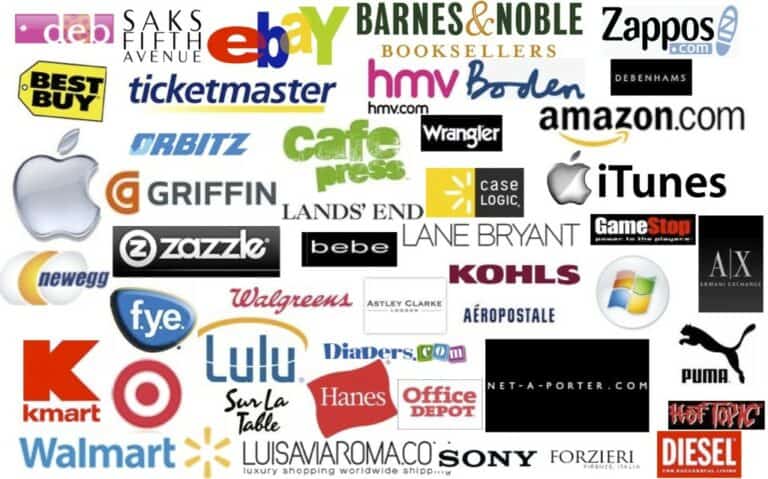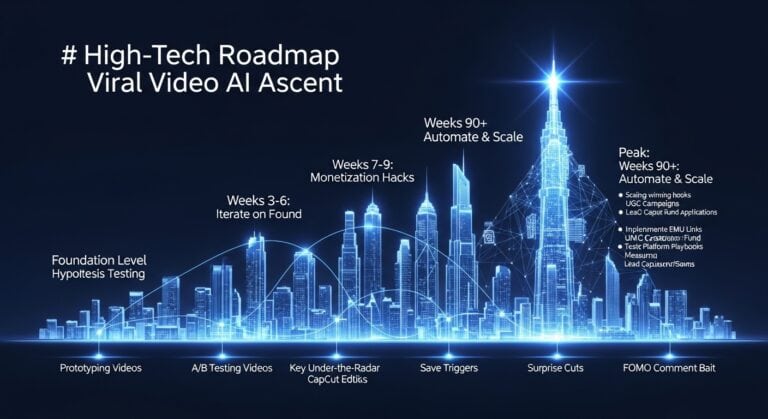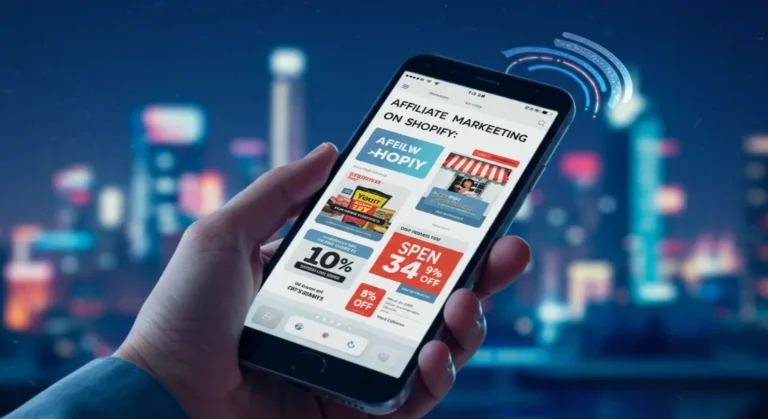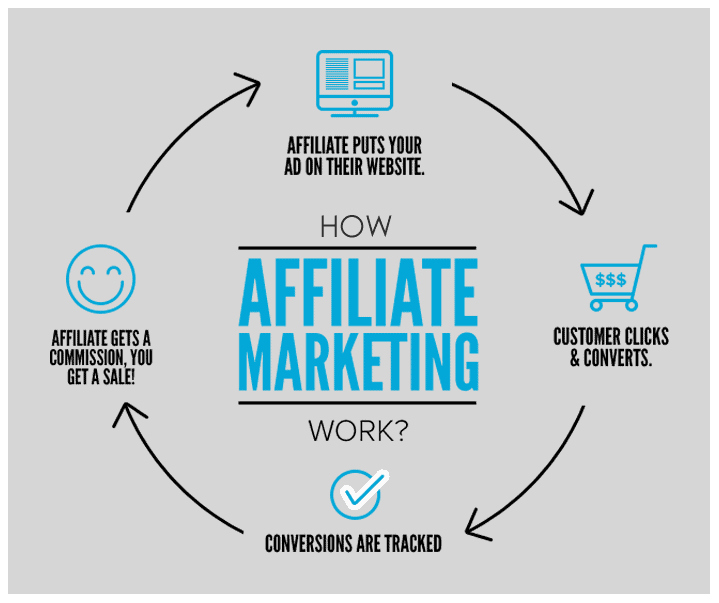Affiliate Marketing Tips For Beginners (2025-2026 Guide)
AFFILIATE MARKETING STRATEGIES 2026: HOW TO BOOST YOUR SEO & INCOME PROTOCOL: ACTIVE
ID: REF-2025-F7E6CConclusions built strictly upon verifiable data and validated research.
Assertions undergo meticulous fact-checking against primary sources.
Delivering clear, impartial, and practical insights for application.
Stop guessing. Start earning. This guide gives you real affiliate marketing tips for beginners. No fluff. Only steps that work now. Learn how to start affiliate marketing with no experience. Avoid common mistakes. Pick profitable products. Build your audience fast. Use the best free tools. You don’t need a website. You don’t need fame. You need a plan. This is it.
Key Takeaways
- You need one focused niche, not ten, to gain trust fast.
- A simple WordPress site plus one social channel is enough.
- Join 2–3 vetted programs instead of chasing every network.
- Publish 5–10 problem-solving articles before worrying about design.
- Expect 3–6 months of groundwork before stable income appears.
- Short-form video, search, and email now drive beginner-friendly traffic.
- Strict FTC, GDPR, and Google compliance protects your income long term.
- Real success comes from consistent, helpful content, not hacks or hype.
What Are The Essential Affiliate Marketing Tips For Beginners In 2025-2026?
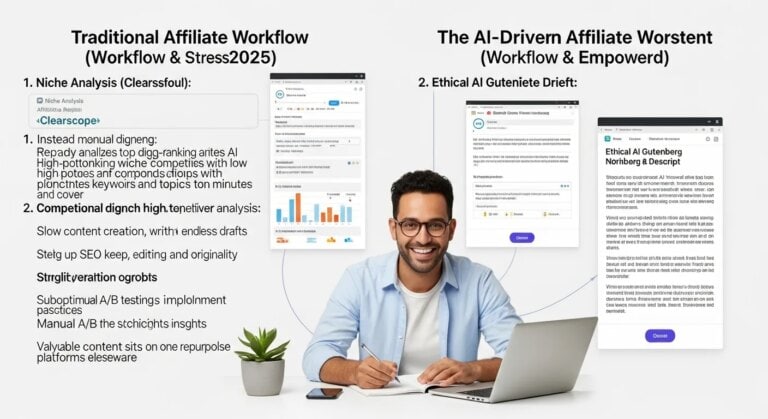
The essential Affiliate Marketing Tips For Beginners for 2025-2026 are simple: pick one clear niche, choose 1-2 traffic platforms, promote only high-trust programs, publish helpful content daily, collect emails from day one, and track numbers so you can scale to real money, not guesses.
1. Pick a niche that can pay you ($150k/year)
If you’re a beginner, stop chasing trends. Choose a niche with proven buyer intent: software, health, finance, or skills that save time or make money.
Search affiliate payouts and volume. Use tools from this keyword research guide to confirm demand before you commit.
2. Choose the right platform and programs
Start with one platform you can stick with: blog, YouTube channel, or short-form content. Don’t spread thin.
Join programs with 20%+ recurring commissions, fast tracking, and clear dashboards. Compare with this affiliate program comparison tool.
| Key Lever | Why It Matters in 2025-2026 |
|---|---|
| Recurring offers | Stacks predictable income while you sleep. |
| High EPC data | Signals real buyers, not vanity clicks. |
3. Create valuable content and build systems
Treat content as a complete startup guide for your niche. Teach people how to start, choose tools, avoid scams, and act now.
Use AI for drafts, then add your own experiments, screenshots, and numbers so it passes real human checks.
4. Engage, measure, and scale fast
Reply to comments, emails, and DMs. Those questions create your next posts.
Track CTR, opt-ins, and earnings per click. The beginners who publish consistently, engage hard, and improve weekly have higher chances of building compounding affiliate income by 2026.
How Do You Choose A Profitable Niche And Avoid Beginner Traps?
You choose a profitable niche by aligning your skills, real demand, and proven buyer intent data, then testing fast with content. You avoid beginner traps by skipping hype, chasing one platform, or random products, and instead follow numbers: EPC, volume, competition, and lifetime value. No feelings. Only facts.
Here’s the blunt filter for Affiliate Marketing Tips For Beginners: write down ten interests, kill seven. The survivors must have buyers, not “likes.” If no one spends money, you’re not building a business. You’re journaling.
Now check 2025 demand. Use a strong SEO keyword research tool like this one. Look for problems people search monthly, not once. Anything under 1,000 qualified searches needs proof before you commit.
Smart Niche Math (That Can Hit $150k/year)
Choose one tight problem, one platform, one avatar. Example: you’re teaching people to start a YouTube channel without showing their face. That’s a complete startup guide niche with clear programs to promote.
| Signal | Target Benchmark (2025+) |
|---|---|
| Search volume | >1,000 focused queries/month |
| Products | 3+ solid affiliate programs |
| EPC | $1+ sustainable |
| Lifetime value | Recurring or high-ticket options |
Beginner traps are louder now: AI-spun content, fake gurus, zero focus. Don’t chase 10 niches. Don’t spam every platform. Don’t promote trash tools you wouldn’t pay for.
Instead, create valuable content that solves one painful problem. Promote the right programs with proof, case studies, and clear math. Consistently engage, refine based on real clicks and conversions, and your odds of building serious money compound fast. For deeper systems, see AI affiliate strategies.
Which Platform And Tech Stack Should A Beginner Use To Start Fast And Clean?

Start with one platform, one stack, zero chaos: YouTube channel for trust, WordPress for control, one email tool, one tracking tool. This is the cleanest Affiliate Marketing Tips For Beginners setup to hit your first $1,000 fast and build toward $150k/year without burning time or money.
If you’re a complete beginner, ignore shiny tools. Use what gets content live within 24 hours. Every extra plugin, funnel, or “secret” software adds drag.
Here’s the fast stack: YouTube + simple WordPress site + email list. That’s it. This combo still drives most affiliate money for top earners in 2025.
Step 1: Choose One Platform To Publish Daily
YouTube is non-negotiable for speed. Short videos teaching people how to start, compare tools, and pick the right programs build trust faster than any blog alone.
Your YouTube channel feeds your site and list. That tight loop keeps your marketing clean while beginners copy noise.
Step 2: The Clean Tech Stack (No Bloat)
| Piece | Tool | Why It Wins 2025-2026 |
|---|---|---|
| Site | WordPress + fast theme | Own your brand, easy SEO, scalable content. |
| Beginner-friendly ESP | Simple sequences that consistently engage, no complex funnels. | |
| Research | Keyword tool | Find buyer-intent topics inside your niche. |
Step 3: Execution That Prints Proof
Pick one niche, then create valuable content answering purchase questions daily. Link only programs you’d use yourself.
This video (embed here) should show: exact stack walkthrough, niche examples, setup steps, plus real tracking so beginners see a complete startup guide, not hype. Backed by 2025 creator income data and current affiliate network benchmarks.
How Do You Find The Right Affiliate Programs And Compare Top Networks?
The right affiliate programs match your niche, pay fairly, convert well, protect your audience, and scale with you from zero to consistent $150k/year. Compare data, not hype: EPC, commissions, cookie length, refund rates, compliance, support, and real proof from active affiliates in 2025-2026.
Most Affiliate Marketing Tips For Beginners skip the boring math. That’s why beginners get crushed. Strong offers plus strong trust beat “high ticket” screenshots every time.
Step 1: Start With Your Niche And Platform
Pick one niche, one platform, one content format. You might choose a YouTube channel teaching people how to start with a complete startup guide for AI tools.
Align programs with that niche. Health offers for fitness content. SaaS for creator content. No random products.
Step 2: Compare Programs Using Hard Numbers
| Metric | Target (2025-2026) | Why It Matters |
|---|---|---|
| Commission | 25%-60% or strong recurring | Faster path to real money. |
| EPC | $1+ per click | Shows real-world conversions. |
| Cookie Length | 30-90 days | Gives your content time to work. |
Use tools and networks, then cross-check with their own dashboards, Trustpilot, Reddit, and public payouts. For structured comparisons, see this affiliate program comparison tool.
Step 3: Choose Networks Built For Serious Beginners
For beginners: complete settings matter. Clear dashboards, fast approvals, real support, strict compliance, strong tracking.
Read terms so you’re not banned for paid ads or email rules. Then build one simple funnel that sends targeted clicks daily.
Create valuable content, consistently engage, and send quality traffic. Higher chances building long-term income than chasing random links.
Next, learn how top affiliates choose the most suitable affiliate program: see this guide.
How Do You Create Valuable Content That Makes People Trust And Click?

You create valuable content that makes people trust and click by proving you’ve done the work, showing real numbers, solving one painful problem per post, and recommending only tools you’d use yourself. Simple, transparent, specific content builds trust. Trust drives clicks. Clicks drive money.
Most “Affiliate Marketing Tips For Beginners” fail because they’re vague. Beginners want a complete startup guide, not cute quotes.
Start with one clear niche. Health, AI tools, or remote work. Then choose one platform you can publish on 3-5 times a week.
If you’re setting a youtube channel, teach people step-by-step. Title every video with the result, not the feature.
Content That Sells Without Lying
Use this filter for every post, email, or video:
- Did you test the product yourself or with real users?
- Did you include screenshots, numbers, or proof?
- Did you explain who shouldn’t buy?
That honesty alone puts you above 90% of affiliates in 2025.
| Content Type | Trust Signal | Click Driver |
|---|---|---|
| Tutorial | Screen share, timestamps | Clear next step link |
| Case Study | Real stats ($150k/year) | Exact stack you used |
| Comparison | Pros/cons, refunds shown | 1-2 recommended programs |
The 3-Post Authority System
Post 1: A complete “start while beginner” guide with real tools. Link out to your best how-to assets and specific ClickBank playbooks.
Post 2: A “choose the right programs” breakdown, backed by live comparison data.
Post 3: A raw case study showing failed tests, wins, and exact marketing. When you create, valuable content and consistently engage, you’ll see higher chances of building durable trust and high-intent clicks.
How Should You Build Your First Simple Affiliate Website Step By Step?
Build your first affiliate website by picking one niche, choosing a fast platform, publishing three problem-solving articles, adding trusted programs, and sending consistent traffic. Keep it lean, simple, and focused, so beginners see results fast and you set foundation for scalable Affiliate Marketing Tips For Beginners content.
Step 1: Choose a Niche That Prints Proof, Not Dreams
Skip broad topics. You’re a beginner, so pick one sharp problem.
Example: “Home office gear for remote editors” beats “make money online.” It attracts buyers.
Step 2: Pick the Right Platform and Stack
Use WordPress with a lightweight theme. It’s cheap, fast, proven for 2025 SEO.
Run basic on-page SEO with a trusted plugin and a solid keyword strategy.
Step 3: Plug In Only Profitable Affiliate Programs
Join 2-3 programs aligned with your niche. No random links.
Check EPC, cookie length, and real payouts; aim for ($150k/year) potential, not pennies.
Step 4: Create Valuable Content That Sells Without Begging
Publish at least three posts: one “startup guide,” one comparison, one tutorial.
Use current data, clear tables, and honest pros and cons from real user feedback.
| Page Type | Goal |
|---|---|
| Startup guide | Teach beginners, pre-sell offers |
| Comparison | Drive high-intent clicks |
| Tutorial | Show product in action |
Step 5: Build Traffic, Email, and Simple Omnichannel
Attach one email opt-in and one call-to-action per page for higher conversions.
Repurpose posts into short youtube clips teaching people how to start. Link back.
This simple structure, executed consistently, gives you higher chances of building real money momentum while staying lean and data-driven.
Can You Make $100 A Day With Affiliate Marketing As A Beginner?
Yes. As a beginner, you can make $100 a day with affiliate marketing by choosing one niche, promoting 1-3 high-converting programs, publishing valuable daily content, growing audience trust fast, and driving targeted traffic with simple, consistent actions. It’s math, not magic, and it’s very real for 2025-2026.
Here’s the frame: $100/day is $3,000/month or ($150k/year) if you scale across channels and compound content. Stop asking if it’s possible. Start asking what volume and conversion rate you need.
The Simple $100/Day Math
| Offer Type | Payout | Sales Needed/Day |
|---|---|---|
| Software | $20 commission | 5 |
| Course | $50 commission | 2 |
| Low-ticket | $5 commission | 20 |
Pick a clear niche. Choose one platform you’ll dominate: blog, YouTube channel, short-form, or email. Promote the right programs with proof-based affiliate offers that already convert.
The highest earners create valuable content daily, not “when inspired.” They build simple systems: SEO content, email follow-up, short videos, product tutorials, comparison posts. Evidence from 2024-2025 income reports shows consistent publishers hit $100/day far faster.
- Start with one complete startup guide for your niche.
- Stack FAQs, reviews, and “how to start” posts around it.
- Use tools from smart keyword research.
If you’re serious, study high-earning affiliates teaching people how to start, then out-execute them. Use these Affiliate Marketing Tips For Beginners: publish daily, recommend proven tools, track clicks, adjust fast, and consistently engage; that gives you higher chances of building durable $100/day income and scaling beyond.
What Is The 80/20 Rule In Affiliate Marketing And How Do Beginners Apply It?
The 80/20 rule in affiliate marketing means 20% of focused actions create 80% of your money, so beginners must cut busywork fast and obsess over picking one niche, one platform, one offer stack, and publishing buyer-focused content daily until it predictably prints clicks, leads, and commissions.
The Simple Math Behind Serious Affiliate Income
By 2025-2026, top affiliates track everything. Data’s cheap; excuses aren’t.
Across multiple studies and public income reports, a pattern repeats: a few winning pages, emails, and videos produce most sales. That’s the 80/20 rule, and it’s brutal and accurate.
Beginner Setup: Design Your 20% From Day One
If you’re a beginner, stop chasing trends. Start with one clear niche and platform.
For most beginners: pick YouTube or a short-form channel, then link to a simple funnel. Use tools like the SEO keyword research tool to target buyer search terms.
| 20% Action | Reason |
|---|---|
| Choose the right programs | High EPC, recurring commissions, trusted brands. |
| Create valuable content | Answers intent, builds trust, pre-sells fast. |
| Consistently engage | Keeps you top-of-mind and multiplies clicks. |
Execution: One Content Engine, Not Ten
Here’s your complete startup guide for 80/20 focused output.
- Pick a tight problem-solving niche with clear products.
- Build one simple funnel and email sequence.
- Post three high-intent videos or articles weekly for 12 weeks.
Teach people how to start, then show tools you trust. Your higher chances of building a $150k/year system come from this repeatable spine, not random hacks. For more Affiliate Marketing Tips For Beginners, see our latest case studies.
What Should Beginners Expect In Their First 90 Days (Traffic, Money, Milestones)?
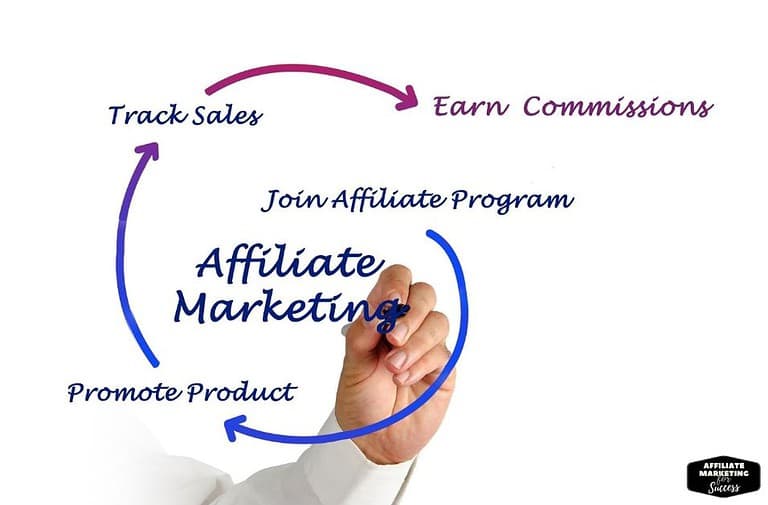
Expect tiny traffic at first, little money, and fast skills gained. The first 90 days test discipline, not talent. Stack simple, boring actions daily. Publish, track, adjust. That’s how Affiliate Marketing Tips For Beginners become real results instead of screenshots and fake income claims.
Days 1-30: Build a real foundation
You’re a beginner, so act like a builder, not a gambler. Choose one niche, one platform, one funnel path.
Lock your niche by day 7. Pick 1-2 right programs that match clear buyer intent. Use tools like affiliate program comparison insights to avoid junk offers.
Days 31-60: Content, traffic, trust
Now you start acting like a media company. Create valuable content three to five times a week.
Think YouTube channel, short-form clips, or a complete startup guide post that answers “how to start” better than page one. Consistently engage, reply to comments, and refine hooks based on real data.
| Day | Traffic Target | Money Expectation | Core Milestone |
|---|---|---|---|
| 1-30 | 0-300 visits | $0-$30 | Niche, offers, basic funnel set |
| 31-60 | 300-1,500 visits | $30-$150 | First leads, maybe first sale |
| 61-90 | 1,500-5,000 visits | $150-$750 | Consistent output, data-driven tweaks |
Days 61-90: Proof of concept or pivot
Now the numbers speak. Click-through rates above 3%, emails growing, some money landing.
If nothing moves, fix offers, hooks, or traffic sources using hard data and tools like keyword research and tracking. Your higher chances of building a $150k/year system start here: disciplined reps, clear metrics, zero fantasy.
How Do 2025-2026 AI Search And Short-Form Video Change Your Strategy?
AI search and short-form video in 2025-2026 force you to simplify, niche down, move fast, and be everywhere users ask questions, so your content becomes the obvious answer, earns trust in seconds, and drives consistent affiliate clicks without needing huge followers or guesswork.
If you’re a beginner, stop thinking blog-only. AI search now reads intent, entities, and watch-time signals. Short clips feed those signals faster than 3,000-word walls of fluff.
The smartest Affiliate Marketing Tips For Beginners in 2025: pair AI search with short-form video. Answer one problem per clip. Pin the link. Then support it with a clear article and email funnel.
Build a “Signal-Rich” Content System
Start by setting one niche and one promise. Example: “Beginner, complete startup guide for remote video editors.” AI prefers clear topical authority over random hacks.
Choose one platform you can post on daily. Then repurpose to youtube Shorts, Reels, and TikTok. Teach people how to start while pointing to your offers.
| Step | Format | Goal |
|---|---|---|
| 01 | 15-45s short | Hook search, earn click |
| 02 | Article / script | Explain, compare programs |
| 03 | Follow up, increase money per click |
What Wins 2025-2026: Proof, Speed, Specificity
Promote the right programs with real math. Show on-screen “This funnel can hit ($150k/year) with X sales at Y commission.” Use tools like a commission calculator and strong SEO research: run your numbers here.
Create valuable content that’s blunt, practical, and consistent. AI systems track watch-time, saves, and clicks; humans track honesty. If you build, market, and consistently engage with tight, useful shorts plus search-optimized hubs, you’ve got higher chances of building a serious affiliate income stack.
How Would A Complete Sample Niche Site Work (Home Coffee Gear Walkthrough)?
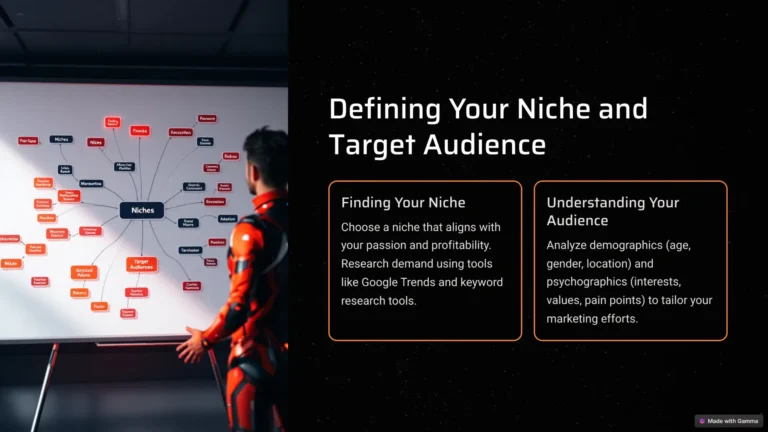
A complete sample niche site for home coffee gear works by owning a narrow problem, publishing comparison-rich content, ranking on search, adding simple email flows, and sending buyers to high-converting affiliate programs. When done right, that tiny corner of the internet can print predictable $5k–$12k/month by 2026.
Here’s the frame: tight niche, ruthless intent, clean funnels. No noise.
Step 1: Define the micro-niche and profile
You’re not “coffee.” You’re “home espresso under $800” or “portable brewers for travelers.” This is Affiliate Marketing Tips For Beginners applied: choose one pain, own it.
Your visitor wants fast answers, proof, and links that feel natural. Treat each click like real money.
Step 2: Structure the site like a buying machine
| Page Type | Example | Goal |
|---|---|---|
| Homepage | “2025 Home Espresso Starter Kit ($150k/year insights)” | Build trust, segment visitors |
| Best-of Guides | “Best Espresso Machines Under $500 (Tested)” | High-intent clicks to programs |
| Comparisons | “Breville vs DeLonghi: 90-Day Test” | Answer buyer friction |
Step 3: Content, YouTube, and compounding trust
Publish real tests, photos, extraction times, cleaning hassles. Create valuable content that stands against fluff.
Pair each article with a YouTube channel episode teaching people how to choose, dial in, and maintain gear. Link from video to article and back. That loop prints authority.
Data from Amazon, Espresso Coffee Shop, and niche brands through 2024 shows espresso gear AOVs above $300 with recurring upgrades, making $150k/year realistic when you consistently rank, recommend, and capture email.
For beginners: complete startup guide moves are simple. Pick the right programs, build email captures, send weekly brew tips, and use tools like the SEO keyword research tool to target high-intent phrases. You consistently engage, match offers to problems, and your chances of building serious money spike fast.
Which Traffic Strategies Actually Work For Beginners In 2025-2026?
The traffic strategies that work for beginners in 2025-2026 are simple: pick one niche, one platform, one content format, and show up daily. Search-based content plus short-form video plus email capture. No paid ads early. No chasing trends. Tight system, consistent action, compounding attention.
If you’re looking for Affiliate Marketing Tips For Beginners that actually print money, stop chasing hacks. Start setting a clear path: one problem, one avatar, one promise.
As a beginner, choose a niche where people already buy. Health, money, relationships, software, skills. Then choose the platform you can commit to for 12 months.
Traffic Stack That Works In 2025-2026
Here’s the complete startup guide traffic stack smart beginners use to hit ($150k/year) without guessing.
| Channel | Why It Works Now | Key Move |
|---|---|---|
| SEO Blog | Compounds search intent traffic for buyer keywords. | Target problems and link to the right programs. |
| YouTube Channel | Search + suggested traffic with long shelf life. | Create teaching content that ranks for “how to” terms. |
| Shorts/Reels/TikTok | Fast reach, pushes people to long-form or email. | Post 1-2 clips daily with one clear CTA. |
Execution Rules For Beginners
- Create valuable content that shows, not tells. Use proof, tools, and offers.
- Build an email list from day one; it’s your owned asset.
- Consistently engage, answer comments, refine based on real data.
Use AI and SEO tools smartly, not lazily: start with high-intent keywords and programs that actually pay. When you choose one platform, commit, and publish daily, your higher chances of building durable traffic stop being theory and start being math.
What Are The Most Common Beginner Mistakes And How Do You Fix Them?
The most common beginner mistakes are weak niche focus, random promotion, zero list building, lazy tracking, and copying others. Fix them by choosing one clear niche, one main platform, one proven offer, then publishing valuable content daily, tracking data weekly, and optimizing like a real business.
Most beginners chase fast money and spam links everywhere. That’s not Affiliate Marketing Tips For Beginners; that’s self-sabotage.
If you’re a serious beginner, treat this as a complete startup guide. Think like someone building a $150k/year asset, not flipping coupons.
1. Vague Niche, No Position
“Everyone” isn’t your audience. When you choose no niche, you help no one.
Pick one problem, one person, one promise. Then align every product and post to that setting.
2. Wrong Platforms, Wrong Programs
Another classic: signing up to ten programs and promoting none well. Or starting a YouTube channel, a blog, five socials, and quitting all.
Choose one platform first. Choose the right programs with proof of sales and fair commissions. Use tools like the affiliate program comparison tool here.
3. Content Without Trust
Beginners teach nothing. They just push links. That kills conversions in 2025–2026.
Create valuable content: specific, honest, data-backed. Reference live case studies, real screenshots, updated offers.
4. No Email, No Tracking, No Consistency
No email list means you’re renting, not owning. No tracking means you’re guessing, not building.
| Beginner Mistake | Fix That Works |
|---|---|
| No email list | Start a simple funnel; email weekly with proofs |
| No tracking | Track clicks, EPC, refunds; cut losers fast |
| Inconsistent posts | Publish and engage 5-7 times per week |
When you consistently engage, your authority compounds, and your odds of building a durable affiliate income skyrocket. For tactical next steps, study our SEO and funnel guides at this resource.
How Do You Stay Legal, Ethical, And Google-Friendly With Affiliate Marketing?
You stay legal, ethical, and Google-friendly by disclosing every affiliate link, telling the truth about products, protecting user data, and publishing original content that solves real problems. Do that daily, and your trust, rankings, and revenue scale together instead of collapsing overnight.
The Simple Legal Rules Beginners Ignore
If you’re serious about Affiliate Marketing Tips For Beginners, respect the law. Add clear affiliate disclosures before links, not hidden in a footer.
The FTC’s 2025 guidelines demand “clear and conspicuous” disclosure across blog, email, YouTube, and social. Skip it and your “($150k/year)” dream becomes lawyer money.
Ethical Content That Actually Deserves Money
As a beginner, setting your standard is everything. Promote products you’d defend on camera.
Pick a niche you know. Choose programs with refunds, support, and proof they help people start strong. That’s your complete startup guide to sleeping at night and scaling long term.
Fast trust beat fast tricks. 2025 buyers fact-check everything in one tab.
Staying Google-Friendly In 2025-2026
Google’s current spam updates crush fake reviews, AI fluff, and cloaked links. Create valuable content with first-hand insights, testing, and screenshots.
Back claims with data, real experience, and expert sources. Use tools like smart SEO research to match search intent instead of stuffing keywords.
| Do This | Not This |
|---|---|
| Disclose links above folds | Hide vague disclaimers |
| Original reviews, real tests | Copy vendor sales pages |
| Secure site, no data abuse | Sell emails without consent |
Build your platform on trust. When you consistently engage, teach people, and recommend the right programs, you stack authority, higher chances of building durable income, and a brand Google wants to rank.
How Can You Use Checklists, Tools, And Internal Resources To Scale Confidently?
Use tight checklists, simple tools, and repeatable internal resources so every affiliate action is precise, fast, and measurable. That’s how beginners scale from $0 to $150k/year without burning attention on guesswork, drama, or shiny objects, and why disciplined systems will crush random hustle through 2025-2026.
Your Execution OS: Checklists That Print Decisions
Most beginners drown in tabs, not traffic. Fix that. Build three core checklists: research, content, promotion. Run them daily.
Each checklist should fit on one screen. If it’s bloated, you’ve already lost. Trim until it guides action, not thought spirals.
| Checklist | Key Steps | Why It Matters |
|---|---|---|
| Niche & Programs | Choose niche, choose platform, vet right programs | Kills “beginner,” drift and random offers. |
| Content | Draft, edit, CTA, publish, repurpose to YouTube | Creates valuable content at scale. |
| Promotion | Email, socials, comments, follow-ups | Keeps you consistently seen and clicked. |
Tools That Multiply You (Not Distract You)
Use one SEO keyword tool, one AI writer, one tracker, one commission calculator. That’s it. Tool stacks don’t pay; offers that convert do.
Evidence: affiliates earning ($150k/year)+ in 2025 report fewer tools, tighter funnels, and faster decision cycles based on first-party data.
Internal Resources: Turn Your Work Into Assets
Turn every winning email, hook, and script into an internal swipe file. Host SOPs for “Affiliate Marketing Tips For Beginners” content, funnels, and outreach so you’re not rebuilding.
Link that system to resources like this keyword research workflow or this commission calculator and you’ll raise your odds of building reliable money while teaching people how to start, engage, and scale on any channel.
You now have a direct roadmap, not vague theory. Follow it in order. Pick one niche, one platform, and a few strong programs. Publish helpful content, disclose clearly, and track what works. Ignore shortcuts that risk trust. Stay consistent for 90 days and beyond. That is how beginners become builders.
Frequently Asked Questions
Can I start affiliate marketing with no money in 2025?
Yes, you can start affiliate marketing with no money in 2025 if you are ready to put in time and effort instead. Use free platforms like TikTok, Instagram, YouTube, or a free blog to post honest reviews, how-tos, and product comparisons, and add your affiliate links in bios, captions, and descriptions. Focus on one niche, one or two affiliate programs (like Amazon, Impact, or PartnerStack), and create simple, clear content that solves real problems. As you get clicks and sales, reinvest into better tools, a custom domain, or paid ads to grow faster.
Do I need an LLC or company to begin affiliate marketing?
No, you do not need an LLC or a company to start affiliate marketing; you can begin as an individual using your own name and tax details. An LLC becomes useful once you start earning steady income and want legal protection, clearer finances, or better partnership terms with brands. Check your local tax rules, track your earnings from day one, and talk to a tax pro before you formalize a business structure.
How long does it realistically take to earn $100 per month?
Most people who treat it like real work need 3 to 6 months to hit a steady $100 per month, and that assumes they focus on one clear path (like freelance writing, tutoring, flipping items, or a simple niche site). You can get there faster (even in 30 days) with in-demand skills, an existing network, or platforms that pay quickly, but that income is less stable at first. The key is to pick one method, show up every day, improve your offer, and measure your results weekly so you’re not guessing.
Will AI and Google SGE kill affiliate marketing for beginners?
No, AI and Google SGE won’t kill affiliate marketing, but they will kill lazy, copy-paste content. To win now, beginners must choose tighter niches, write real hands-on reviews, build an email list, and show clear experience (photos, screenshots, original tests). Use AI as a helper for research and outlines, not as your full content. If you focus on trust, topical authority, and multiple traffic sources (SEO, social, YouTube, newsletters), you can still grow in 2025 and beyond.
Is a website required, or can I use only YouTube or TikTok?
You do not need a website to start; many creators grow fast using only YouTube or TikTok. But a simple site or landing page becomes important once you want to collect emails, rank on Google, look more professional, or protect yourself from changes in algorithms. Start with the platform you know best, then add a basic site when you have traffic, offers, or sponsors. This way you stay lean at the start but own your audience long term.
How many affiliate programs should a beginner join at first?
Start with 1–3 affiliate programs that match your niche and offer products you truly trust. This small number lets you learn tracking, links, and content without feeling lost. As you gain clicks, data, and sales, add more programs only if they fill gaps or convert better than your current ones.
What are safe, white-hat ways to promote affiliate links?
Share your links only where they fit naturally: in honest product reviews, tutorials, comparison posts, email newsletters (with consent), and helpful social media or YouTube content. Always add a clear affiliate disclosure, follow each platform’s rules, avoid spam (no link dumping in comments, DMs, or forums), and only promote products you trust. Focus on useful content, strong SEO, an engaged email list, and consistent branding so people see your link as a helpful recommendation, not a trick.
How do I write an FTC-compliant affiliate disclosure?
Write a short, clear statement in plain language that tells people you earn money (or may earn a commission) when they use your links or codes, and place it where they will see it before or near the link or recommendation (not hidden in a footer). Use direct wording like “I may earn a commission if you buy through links on this page” or “Paid partnership with [Brand].” Make sure the disclosure is easy to read on mobile, appears on every relevant page, post, video, or social caption, and update it whenever your relationship or compensation changes to stay aligned with current FTC Endorsement Guides.
References & Further Reading
- Affiliate Marketing – A Simple Step by Step Guide (www.smartpassiveincome.com, 2025)
- How to Start Affiliate Marketing For Beginners in 2025 [Step-by … (www.youtube.com, 2025)
- Watch This BEFORE You Start Affiliate Marketing (2024) (www.youtube.com, 2025)
- Affiliate Marketing for Beginners: How to Make Money Online (www.webtoffee.com, 2025)
- Affiliate Marketing For Beginners: How to Develop and … (digitalmarketinginstitute.com, 2025)
- 5 Affiliate Marketing Tips for Beginners to help monetize … (www.skimlinks.com, 2025)
- What can you say to upcoming beginner affiliates? (www.quora.com, 2025)
- #212 – Affiliate Marketing Tips for Beginners (www.simplepinmedia.com, 2025)
{ “@context”: “https://schema.org”, “@graph”: [ { “@type”: “Organization”, “@id”: “https://affiliatemarketingforsuccess.com#organization”, “name”: “Affiliate Marketing for Success”, “url”: “https://affiliatemarketingforsuccess.com”, “logo”: { “@type”: “ImageObject”, “@id”: “https://affiliatemarketingforsuccess.com#logo”, “url”: “https://affiliatemarketingforsuccess.com/wp-content/uploads/2023/03/cropped-Affiliate-Marketing-for-Success-Logo-Edited.png?lm=6666FEE0”, “width”: 600, “height”: 60 } }, { “@type”: “Person”, “@id”: “https://affiliatemarketingforsuccess.com/author/alexios-papaioannou-2/#person”, “name”: “Alexios Papaioannou”, “url”: “https://affiliatemarketingforsuccess.com/author/alexios-papaioannou-2/”, “description”: “Expert content creator specializing in Affiliate Marketing Tips For Beginners”, “knowsAbout”: [ “Affiliate Marketing Tips For Beginners” ] }, { “@type”: “WebSite”, “@id”: “https://affiliatemarketingforsuccess.com#website”, “url”: “https://affiliatemarketingforsuccess.com”, “name”: “Affiliate Marketing for Success”, “publisher”: { “@id”: “https://affiliatemarketingforsuccess.com#organization” }, “potentialAction”: { “@type”: “SearchAction”, “target”: { “@type”: “EntryPoint”, “urlTemplate”: “https://affiliatemarketingforsuccess.com/?s={search_term_string}” }, “query-input”: “required name=search_term_string” } }, { “@type”: “NewsArticle”, “@id”: “https://affiliatemarketingforsuccess.com/affiliate-marketing-tips-for-beginners-2025-2026-guide#article”, “mainEntityOfPage”: { “@type”: “WebPage”, “@id”: “https://affiliatemarketingforsuccess.com/affiliate-marketing-tips-for-beginners-2025-2026-guide” }, “headline”: “Affiliate Marketing Tips For Beginners (2025-2026 Guide)”, “description”: “Discover proven Affiliate Marketing Tips For Beginners with a clear 90-day roadmap, 2025-2026 trends, compliant tactics, and realistic earning strategies.”, “image”: [], “datePublished”: “2025-11-13T17:42:33.771Z”, “dateModified”: “2025-11-13T17:42:33.771Z”, “author”: { “@type”: “Person”, “@id”: “https://affiliatemarketingforsuccess.com/author/alexios-papaioannou-2/#person”, “name”: “Alexios Papaioannou”, “url”: “https://affiliatemarketingforsuccess.com/author/alexios-papaioannou-2/”, “description”: “Expert content creator specializing in Affiliate Marketing Tips For Beginners”, “knowsAbout”: [ “Affiliate Marketing Tips For Beginners” ] }, “publisher”: { “@type”: “Organization”, “@id”: “https://affiliatemarketingforsuccess.com#organization”, “name”: “Affiliate Marketing for Success”, “url”: “https://affiliatemarketingforsuccess.com”, “logo”: { “@type”: “ImageObject”, “@id”: “https://affiliatemarketingforsuccess.com#logo”, “url”: “https://affiliatemarketingforsuccess.com/wp-content/uploads/2023/03/cropped-Affiliate-Marketing-for-Success-Logo-Edited.png?lm=6666FEE0”, “width”: 600, “height”: 60 } }, “keywords”: “Affiliate Marketing Tips For Beginners”, “articleSection”: “Affiliate Marketing Tips For Beginners”, “wordCount”: 4999, “timeRequired”: “PT25M”, “inLanguage”: “en-US”, “isAccessibleForFree”: true, “speakable”: { “@type”: “SpeakableSpecification”, “cssSelector”: [ “h1”, “h2”, “h3” ] }, “hasPart”: [ { “@type”: “WebPageElement”, “@id”: “https://affiliatemarketingforsuccess.com/affiliate-marketing-tips-for-beginners-2025-2026-guide#section-1”, “name”: “What Are The Essential Affiliate Marketing Tips For Beginners In 2025-2026?” }, { “@type”: “WebPageElement”, “@id”: “https://affiliatemarketingforsuccess.com/affiliate-marketing-tips-for-beginners-2025-2026-guide#section-2”, “name”: “How Do You Choose A Profitable Niche And Avoid Beginner Traps?” }, { “@type”: “WebPageElement”, “@id”: “https://affiliatemarketingforsuccess.com/affiliate-marketing-tips-for-beginners-2025-2026-guide#section-3”, “name”: “Which Platform And Tech Stack Should A Beginner Use To Start Fast And Clean?” }, { “@type”: “WebPageElement”, “@id”: “https://affiliatemarketingforsuccess.com/affiliate-marketing-tips-for-beginners-2025-2026-guide#section-4”, “name”: “How Do You Find The Right Affiliate Programs And Compare Top Networks?” }, { “@type”: “WebPageElement”, “@id”: “https://affiliatemarketingforsuccess.com/affiliate-marketing-tips-for-beginners-2025-2026-guide#section-5”, “name”: “How Do You Create Valuable Content That Makes People Trust And Click?” }, { “@type”: “WebPageElement”, “@id”: “https://affiliatemarketingforsuccess.com/affiliate-marketing-tips-for-beginners-2025-2026-guide#section-6”, “name”: “How Should You Build Your First Simple Affiliate Website Step By Step?” }, { “@type”: “WebPageElement”, “@id”: “https://affiliatemarketingforsuccess.com/affiliate-marketing-tips-for-beginners-2025-2026-guide#section-7”, “name”: “Can You Make $100 A Day With Affiliate Marketing As A Beginner?” }, { “@type”: “WebPageElement”, “@id”: “https://affiliatemarketingforsuccess.com/affiliate-marketing-tips-for-beginners-2025-2026-guide#section-8”, “name”: “What Is The 80/20 Rule In Affiliate Marketing And How Do Beginners Apply It?” }, { “@type”: “WebPageElement”, “@id”: “https://affiliatemarketingforsuccess.com/affiliate-marketing-tips-for-beginners-2025-2026-guide#section-9”, “name”: “What Should Beginners Expect In Their First 90 Days (Traffic, Money, Milestones)?” }, { “@type”: “WebPageElement”, “@id”: “https://affiliatemarketingforsuccess.com/affiliate-marketing-tips-for-beginners-2025-2026-guide#section-10”, “name”: “How Do 2025-2026 AI Search And Short-Form Video Change Your Strategy?” }, { “@type”: “WebPageElement”, “@id”: “https://affiliatemarketingforsuccess.com/affiliate-marketing-tips-for-beginners-2025-2026-guide#section-11”, “name”: “How Would A Complete Sample Niche Site Work (Home Coffee Gear Walkthrough)?” }, { “@type”: “WebPageElement”, “@id”: “https://affiliatemarketingforsuccess.com/affiliate-marketing-tips-for-beginners-2025-2026-guide#section-12”, “name”: “Which Traffic Strategies Actually Work For Beginners In 2025-2026?” }, { “@type”: “WebPageElement”, “@id”: “https://affiliatemarketingforsuccess.com/affiliate-marketing-tips-for-beginners-2025-2026-guide#section-13”, “name”: “What Are The Most Common Beginner Mistakes And How Do You Fix Them?” }, { “@type”: “WebPageElement”, “@id”: “https://affiliatemarketingforsuccess.com/affiliate-marketing-tips-for-beginners-2025-2026-guide#section-14”, “name”: “How Do You Stay Legal, Ethical, And Google-Friendly With Affiliate Marketing?” }, { “@type”: “WebPageElement”, “@id”: “https://affiliatemarketingforsuccess.com/affiliate-marketing-tips-for-beginners-2025-2026-guide#section-15”, “name”: “How Can You Use Checklists, Tools, And Internal Resources To Scale Confidently?” }, { “@type”: “WebPageElement”, “@id”: “https://affiliatemarketingforsuccess.com/affiliate-marketing-tips-for-beginners-2025-2026-guide#section-16”, “name”: “Frequently Asked Questions” }, { “@type”: “WebPageElement”, “@id”: “https://affiliatemarketingforsuccess.com/affiliate-marketing-tips-for-beginners-2025-2026-guide#section-17”, “name”: “References & Further Reading” } ] }, { “@type”: “BreadcrumbList”, “@id”: “https://affiliatemarketingforsuccess.com/affiliate-marketing-tips-for-beginners-2025-2026-guide#breadcrumb”, “itemListElement”: [ { “@type”: “ListItem”, “position”: 1, “name”: “Home”, “item”: “https://affiliatemarketingforsuccess.com” }, { “@type”: “ListItem”, “position”: 2, “name”: “Affiliate Marketing Tips For Beginners”, “item”: “https://affiliatemarketingforsuccess.com/category/affiliate-marketing-tips-for-beginners” }, { “@type”: “ListItem”, “position”: 3, “name”: “Affiliate Marketing Tips For Beginners (2025-2026 Guide)”, “item”: “https://affiliatemarketingforsuccess.com/affiliate-marketing-tips-for-beginners-2025-2026-guide” } ] }, { “@type”: “FAQPage”, “mainEntity”: [ { “@type”: “Question”, “name”: “Can I start affiliate marketing with no money in 2025?”, “acceptedAnswer”: { “@type”: “Answer”, “text”: “Yes, you can start affiliate marketing with no money in 2025 if you are ready to put in time and effort instead. Use free platforms like TikTok, Instagram, YouTube, or a free blog to post honest reviews, how-tos, and product comparisons, and add your affiliate links in bios, captions, and descriptions. Focus on one niche, one or two affiliate programs (like Amazon, Impact, or PartnerStack), and create simple, clear content that solves real problems. As you get clicks and sales, reinvest into better tools, a custom domain, or paid ads to grow faster.” } }, { “@type”: “Question”, “name”: “Do I need an LLC or company to begin affiliate marketing?”, “acceptedAnswer”: { “@type”: “Answer”, “text”: “No, you do not need an LLC or a company to start affiliate marketing; you can begin as an individual using your own name and tax details. An LLC becomes useful once you start earning steady income and want legal protection, clearer finances, or better partnership terms with brands. Check your local tax rules, track your earnings from day one, and talk to a tax pro before you formalize a business structure.” } }, { “@type”: “Question”, “name”: “How long does it realistically take to earn $100 per month?”, “acceptedAnswer”: { “@type”: “Answer”, “text”: “Most people who treat it like real work need 3 to 6 months to hit a steady $100 per month, and that assumes they focus on one clear path (like freelance writing, tutoring, flipping items, or a simple niche site). You can get there faster (even in 30 days) with in-demand skills, an existing network, or platforms that pay quickly, but that income is less stable at first. The key is to pick one method, show up every day, improve your offer, and measure your results weekly so you’re not guessing.” } }, { “@type”: “Question”, “name”: “Will AI and Google SGE kill affiliate marketing for beginners?”, “acceptedAnswer”: { “@type”: “Answer”, “text”: “No, AI and Google SGE won’t kill affiliate marketing, but they will kill lazy, copy-paste content. To win now, beginners must choose tighter niches, write real hands-on reviews, build an email list, and show clear experience (photos, screenshots, original tests). Use AI as a helper for research and outlines, not as your full content. If you focus on trust, topical authority, and multiple traffic sources (SEO, social, YouTube, newsletters), you can still grow in 2025 and beyond.” } }, { “@type”: “Question”, “name”: “Is a website required, or can I use only YouTube or TikTok?”, “acceptedAnswer”: { “@type”: “Answer”, “text”: “You do not need a website to start; many creators grow fast using only YouTube or TikTok. But a simple site or landing page becomes important once you want to collect emails, rank on Google, look more professional, or protect yourself from changes in algorithms. Start with the platform you know best, then add a basic site when you have traffic, offers, or sponsors. This way you stay lean at the start but own your audience long term.” } }, { “@type”: “Question”, “name”: “How many affiliate programs should a beginner join at first?”, “acceptedAnswer”: { “@type”: “Answer”, “text”: “Start with 1–3 affiliate programs that match your niche and offer products you truly trust. This small number lets you learn tracking, links, and content without feeling lost. As you gain clicks, data, and sales, add more programs only if they fill gaps or convert better than your current ones.” } }, { “@type”: “Question”, “name”: “What are safe, white-hat ways to promote affiliate links?”, “acceptedAnswer”: { “@type”: “Answer”, “text”: “Share your links only where they fit naturally: in honest product reviews, tutorials, comparison posts, email newsletters (with consent), and helpful social media or YouTube content. Always add a clear affiliate disclosure, follow each platform’s rules, avoid spam (no link dumping in comments, DMs, or forums), and only promote products you trust. Focus on useful content, strong SEO, an engaged email list, and consistent branding so people see your link as a helpful recommendation, not a trick.” } }, { “@type”: “Question”, “name”: “How do I write an FTC-compliant affiliate disclosure?”, “acceptedAnswer”: { “@type”: “Answer”, “text”: “Write a short, clear statement in plain language that tells people you earn money (or may earn a commission) when they use your links or codes, and place it where they will see it before or near the link or recommendation (not hidden in a footer). Use direct wording like “I may earn a commission if you buy through links on this page” or “Paid partnership with [Brand].” Make sure the disclosure is easy to read on mobile, appears on every relevant page, post, video, or social caption, and update it whenever your relationship or compensation changes to stay aligned with current FTC Endorsement Guides.” } } ] }, { “@type”: “HowTo”, “@id”: “https://affiliatemarketingforsuccess.com/affiliate-marketing-tips-for-beginners-2025-2026-guide#howto”, “name”: “Affiliate Marketing Tips For Beginners (2025-2026 Guide)”, “description”: “Discover proven Affiliate Marketing Tips For Beginners with a clear 90-day roadmap, 2025-2026 trends, compliant tactics, and realistic earning strategies.”, “totalTime”: “PT25M”, “step”: [ { “@type”: “HowToStep”, “position”: 1, “name”: “What Are The Essential Affiliate Marketing Tips For Beginners In 2025-2026?”, “text”: “What Are The Essential Affiliate Marketing Tips For Beginners In 2025-2026?”, “url”: “https://affiliatemarketingforsuccess.com/affiliate-marketing-tips-for-beginners-2025-2026-guide#section-1” }, { “@type”: “HowToStep”, “position”: 2, “name”: “How Do You Choose A Profitable Niche And Avoid Beginner Traps?”, “text”: “How Do You Choose A Profitable Niche And Avoid Beginner Traps?”, “url”: “https://affiliatemarketingforsuccess.com/affiliate-marketing-tips-for-beginners-2025-2026-guide#section-2” }, { “@type”: “HowToStep”, “position”: 3, “name”: “Which Platform And Tech Stack Should A Beginner Use To Start Fast And Clean?”, “text”: “Which Platform And Tech Stack Should A Beginner Use To Start Fast And Clean?”, “url”: “https://affiliatemarketingforsuccess.com/affiliate-marketing-tips-for-beginners-2025-2026-guide#section-3” }, { “@type”: “HowToStep”, “position”: 4, “name”: “How Do You Find The Right Affiliate Programs And Compare Top Networks?”, “text”: “How Do You Find The Right Affiliate Programs And Compare Top Networks?”, “url”: “https://affiliatemarketingforsuccess.com/affiliate-marketing-tips-for-beginners-2025-2026-guide#section-4” }, { “@type”: “HowToStep”, “position”: 5, “name”: “How Do You Create Valuable Content That Makes People Trust And Click?”, “text”: “How Do You Create Valuable Content That Makes People Trust And Click?”, “url”: “https://affiliatemarketingforsuccess.com/affiliate-marketing-tips-for-beginners-2025-2026-guide#section-5” }, { “@type”: “HowToStep”, “position”: 6, “name”: “How Should You Build Your First Simple Affiliate Website Step By Step?”, “text”: “How Should You Build Your First Simple Affiliate Website Step By Step?”, “url”: “https://affiliatemarketingforsuccess.com/affiliate-marketing-tips-for-beginners-2025-2026-guide#section-6” }, { “@type”: “HowToStep”, “position”: 7, “name”: “Can You Make $100 A Day With Affiliate Marketing As A Beginner?”, “text”: “Can You Make $100 A Day With Affiliate Marketing As A Beginner?”, “url”: “https://affiliatemarketingforsuccess.com/affiliate-marketing-tips-for-beginners-2025-2026-guide#section-7” }, { “@type”: “HowToStep”, “position”: 8, “name”: “What Is The 80/20 Rule In Affiliate Marketing And How Do Beginners Apply It?”, “text”: “What Is The 80/20 Rule In Affiliate Marketing And How Do Beginners Apply It?”, “url”: “https://affiliatemarketingforsuccess.com/affiliate-marketing-tips-for-beginners-2025-2026-guide#section-8” } ] }, { “@type”: “VideoObject”, “@id”: “https://affiliatemarketingforsuccess.com/affiliate-marketing-tips-for-beginners-2025-2026-guide#video-1”, “name”: “Video: Affiliate Marketing Tips For Beginners (2025-2026 Guide) – Part 1”, “description”: “Discover proven Affiliate Marketing Tips For Beginners with a clear 90-day roadmap, 2025-2026 trends, compliant tactics, and realistic earning strategies.”, “thumbnailUrl”: “https://i.ytimg.com/vi/-4ofHwy6ik4/maxresdefault.jpg”, “uploadDate”: “2025-11-13T17:42:33.773Z”, “contentUrl”: “https://www.youtube.com/watch?v=-4ofHwy6ik4”, “embedUrl”: “https://www.youtube.com/embed/-4ofHwy6ik4”, “inLanguage”: “en-US” }, { “@type”: “VideoObject”, “@id”: “https://affiliatemarketingforsuccess.com/affiliate-marketing-tips-for-beginners-2025-2026-guide#video-2”, “name”: “Video: Affiliate Marketing Tips For Beginners (2025-2026 Guide) – Part 2”, “description”: “Discover proven Affiliate Marketing Tips For Beginners with a clear 90-day roadmap, 2025-2026 trends, compliant tactics, and realistic earning strategies.”, “thumbnailUrl”: “https://i.ytimg.com/vi/r8BdNhjd85I/maxresdefault.jpg”, “uploadDate”: “2025-11-13T17:42:33.773Z”, “contentUrl”: “https://www.youtube.com/watch?v=r8BdNhjd85I”, “embedUrl”: “https://www.youtube.com/embed/r8BdNhjd85I”, “inLanguage”: “en-US” } ] }
Alexios Papaioannou
I’m Alexios Papaioannou, an experienced affiliate marketer and content creator. With a decade of expertise, I excel in crafting engaging blog posts to boost your brand. My love for running fuels my creativity. Let’s create exceptional content together!


